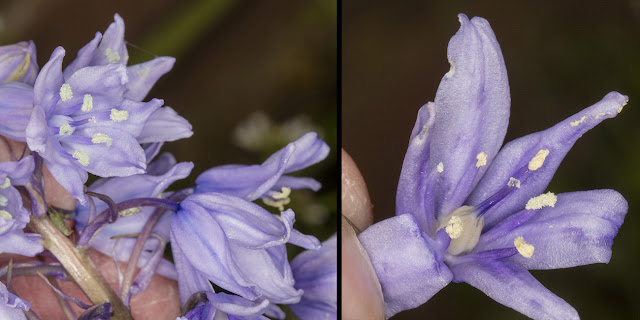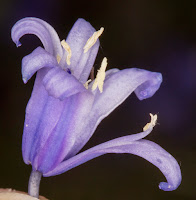 |
| Bluebells in Hangrove Wood, Downe Bank. Hyacinthoides non-scripta. 16 April 2016. |
These are the true English bluebells. In Scotland, you call Bluebells what we English call Harebells. They are just as pretty individually, if not more so, but they don't carpet the woods like these ones.
If you have bluebells in your garden, they are probably hybrids. Here is the English bluebell.
 |
| English Bluebell, Hyacinthoides non-scripta. Hayes Common, 27 April 2016. |
Narrow leaves. A long slender stem that is weak at the top, so that the flowers usually nearly all droop to one side.
The petals only curl open at the tip, because the anthers are attached to the insides of the petals for most of their length.
This is illustrated in the photo on the right.
There exists a much more robust bluebell, the Spanish Bluebell. I only have one photo because they are not commonly seen.
 |
| Spanish Bluebell, Hyacinthoides hispanica. Hutchinson's Bank, 20 April 2016. |
 |
| Spanish Bluebell, Hyacinthoides hispanica. Hutchinson's Bank, 20 April 2016. |
Garden bluebells are often mistaken for this robust flower, but in fact they are a hybrid between the two species and have completely intermediate characteristics.
 |
| Hybrid Bluebell, Hyacinthoides x massartiana. Hayes, 25 April 2016. |
 |
| Hybrid Bluebell, Hyacinthoides x massartiana. Hayes, 25 April 2016. |
It comes in white and pink varieties. The native bluebells throw up occasional white flowers, but if you see pink, you'll know it's the hybrid.

I was thinking of these just yesterday. The Texas state flower, even during this year's deluges, covers the hills, Of course, the are a lupin, not a hyacinthus, with an entirely different structure, especially close up, but they are like your English wild ones in covering, literally covering, the field. And thank you for the new photos, too.
ReplyDelete